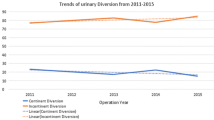Abstract
Introduction
Preoperative factors favoring the performance of non-orthotopic bladder substitution (OBS) after radical cystectomy for muscle-invasive bladder cancer were identified.
Patients and methods
We retrospectively reviewed the medical records of 730 patients who underwent radical cystectomy for urothelial carcinoma of the bladder. After excluding 75 patients who were unable to undergo OBS due to the tumor location or elevated serum creatinine level, we assessed the preoperative factors in the remaining 655 patients. Multivariate logistic regression analysis was performed to identify the independent preoperative predictors of type of urinary diversion.
Results
Of the 655 patients, 171 (26.1%) underwent non-OBS. Patients who underwent non-OBS were more likely to be older and females, to have a lower educational status, non-organ confined disease, more comorbid medical conditions, more impaired performance status, lower body mass index, anemia, azotemia, and hypoalbuminemia, and to be treated by less-experienced surgeons (P < 0.05 each). After adjusting for provider-based factors, multivariate analysis showed that factors independently associated with non-OBS included advanced age (odds ratio [OR] 4.10, P < 0.001), female gender (OR 2.08, P = 0.027), ECOG performance status (≥1 vs 0, OR 5.20, P < 0.001), low educational status (OR 1.59, P = 0.042), clinically node-positive disease (OR 2.36, P = 0.003), anemia (OR 1.67, P = 0.041), azotemia (OR 3.97, P < 0.001), and hypoalbuminemia (OR 1.84, P = 0.046).
Conclusion
Several patient-based as well as provider-based factors were associated with the type of urinary diversion after radical cystectomy. Advanced age, female gender, low performance status, low education level, clinically node-positive disease, anemia, hypoalbuminemia, and azotemia were associated with non-OBS, as surgery was performed by relatively inexperienced surgeons.
Similar content being viewed by others
References
Stenzl A, Cowan NC, De Santis M, Jakse G, Kuczyk MA, Merseburger AS, Ribal MJ, Sherif A, Witjes JA (2009) The updated EAU guidelines on muscle-invasive and metastatic bladder cancer. Eur Urol 55:815–825
Hautmann RE (2003) Urinary diversion: ileal conduit to neobladder. J Urol 169:834–842
Hobisch A, Tosun K, Kinzl J, Kemmler G, Bartsch G, Holtl L, Stenzl A (2001) Life after cystectomy and orthotopic neobladder versus ileal conduit urinary diversion. Semin Urol Oncol 19:18–23
Dutta SC, Chang SC, Coffey CS, Smith JA Jr, Jack G, Cookson MS (2002) Health related quality of life assessment after radical cystectomy: comparison of ileal conduit with continent orthotopic neobladder. J Urol 168:164–167
Hautmann RE, Abol-Enein H, Hafez K, Haro I, Mansson W, Mills RD, Montie JD, Sagalowsky AI, Stein JP, Stenzl A, Studer UE, Volkmer BG (2007) Urinary diversion. Urology 69:17–49
Hautmann RE, de Petriconi RC, Volkmer BG (2010) Lessons learned from 1,000 neobladders: the 90-day complication rate. J Urol 184:990–994
Studer UE, Zingg EJ (1997) Ileal orthotopic bladder substitutes. What we have learned from 12 years’ experience with 200 patients. Urol Clin N Am 24:781–793
Gore JL, Litwin MS (2009) Quality of care in bladder cancer: trends in urinary diversion following radical cystectomy. World J Urol 27:45–50
Gore JL, Saigal CS, Hanley JM, Schonlau M, Litwin MS (2006) Variations in reconstruction after radical cystectomy. Cancer 107:729–737
Chung D, Hersey K, Fleshner N (2005) Differences between urologists in United States and Canada in approach to bladder cancer. Urology 65:919–925
Abol-Enein H, Ghoneim MA (1994) A novel uretero-ileal reimplantation technique: the serous lined extramural tunnel. A preliminary report. J Urol 151:1193–1197
Hautmann RE (2001) The ileal neobladder. Atlas Urol Clin N Am 9:85–108
Hollowell CM, Christiano AP, Steinberg GD (2000) Technique of Hautmann ileal neobladder with chimney modification: interim results in 50 patients. J Urol 163:47–50
Studer UE, Spiegel T, Casanova GA, Springer J, Gerber E, Ackermann DK, Gurtner F, Zingg EJ (1991) Ileal bladder substitute: antireflux nipple or afferent tubular segment? Eur Urol 20:315–326
Thuroff JW, Alken P, Riedmiller H, Engelmann U, Jacobi GH, Hohenfellner R (1986) The Mainz pouch (mixed augmentation ileum and cecum) for bladder augmentation and continent diversion. J Urol 136:17–26
Charlson M, Szatrowski TP, Peterson J, Gold J (1994) Validation of a combined comorbidity index. J Clin Epidemiol 47:1245–1251
Greene FL, Page DL, Fleming ID et al (2002) AJCC cancer staging manual, 6th edn. Springer, New York
Lowrance WT, Rumohr JA, Clark PE, Chang SS, Smith JA Jr, Cookson MS (2009) Urinary diversion trends at a high volume, single American tertiary care center. J Urol 182:2369–2374
Gore JL, Yu HY, Setodji C, Hanley JM, Litwin MS, Saigal CS (2010) Urinary diversion and morbidity after radical cystectomy for bladder cancer. Cancer 116:331–339
Stein JP, Penson DF, Lee C, Cai J, Miranda G, Skinner DG (2009) Long-term oncological outcomes in women undergoing radical cystectomy and orthotopic diversion for bladder cancer. J Urol 181:2052–2058
Gilbert SM, Wood DP, Dunn RL, Weizer AZ, Lee CT, Montie JE, Wei JT (2007) Measuring health-related quality of life outcomes in bladder cancer patients using the bladder cancer index (BCI). Cancer 109:1756–1762
Hautmann RE, Simon J (1999) Ileal neobladder and local recurrence of bladder cancer: patterns of failure and impact on function in men. J Urol 162:1963–1966
Lebret T, Herve JM, Yonneau L, Molinie V, Barre P, Lugagne PM, Butreau M, Mignot L, Botto H (2002) After cystectomy, is it justified to perform a bladder replacement for patients with lymph node positive bladder cancer? Eur Urol 42:344–349
Gregg JR, Cookson MS, Phillips S, Salem S, Chang SS, Clark PE, Davis R, Stimson CJ Jr, Aghazadeh M, Smith JA Jr, Barocas DA (2011) Effect of preoperative nutritional deficiency on mortality after radical cystectomy for bladder cancer. J Urol 185:90–96
Conflict of interest
There are no conflicts of interest or financial disclosures from any authors.
Author information
Authors and Affiliations
Corresponding author
Rights and permissions
About this article
Cite this article
Jeong, I.G., You, D., Kim, J. et al. Factors associated with non-orthotopic urinary diversion after radical cystectomy. World J Urol 30, 815–820 (2012). https://doi.org/10.1007/s00345-012-0846-9
Received:
Accepted:
Published:
Issue Date:
DOI: https://doi.org/10.1007/s00345-012-0846-9



